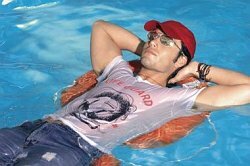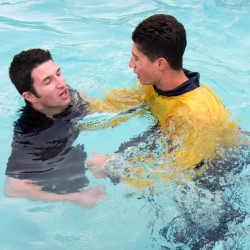Lifeguarding the Pool
Pool lifeguards work in enclosed water like swimming pools and waterparks. They are trained to use specific equipment according to their leisure centre.
When they act, they do so as members of a team and over very short distances. Most pool rescues involve a swim of less than 15 metres, but can involve any part of the pool.
They will generally have to rescue people who got into difficulties because of their limited skills or confidence, or help those who have suffered from a medical problem.
Other tasks include looking after bather's comfort and entertainment, or tidying the floats and other toys. They may need to hop into the pool a few times each day to sort things out or assist swimmers.
Qualifications
Please note: Pool lifeguard qualifications are awarded by national organisations in your country, not by the Free Lifesaving Society.
In Britain the Swimming Teachers Association (STA) trains to the National Aquatic Rescue Standard (NARS).
The course takes a minimum of 38 hours and the qualification is valid for two years from the date of assessment.
A minimum of 20 hours training must be logged in those two years for the individual
to be eligible to submit for a renewal examination.
Ongoing Training
The employer of the lifeguard must also provide a minimum of 1 hour of training per month to comply with health and safety guidelines. Weekly training sessions would be optimal.
The training should include a module about the use of a spinal board, a specialist piece of rescue equipment designed for immobilizing a casualty suspected of suffering a spinal cord injury.

Some people think that pool lifeguarding is just chilling out for a while. NOT!! It often is quiet, but can get hectic very fast.
